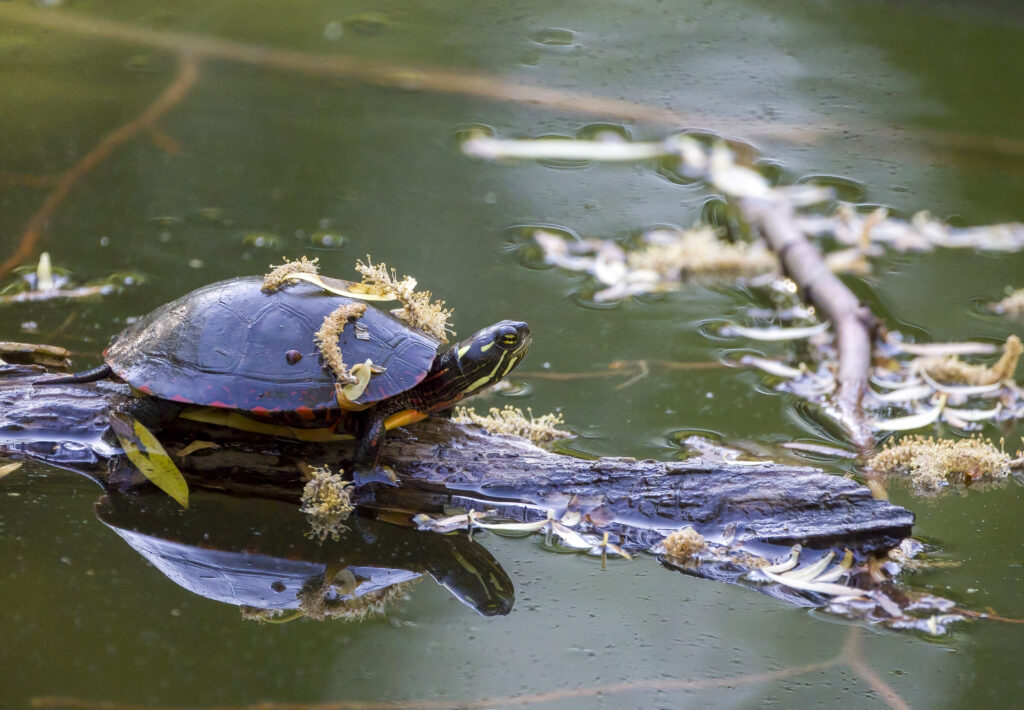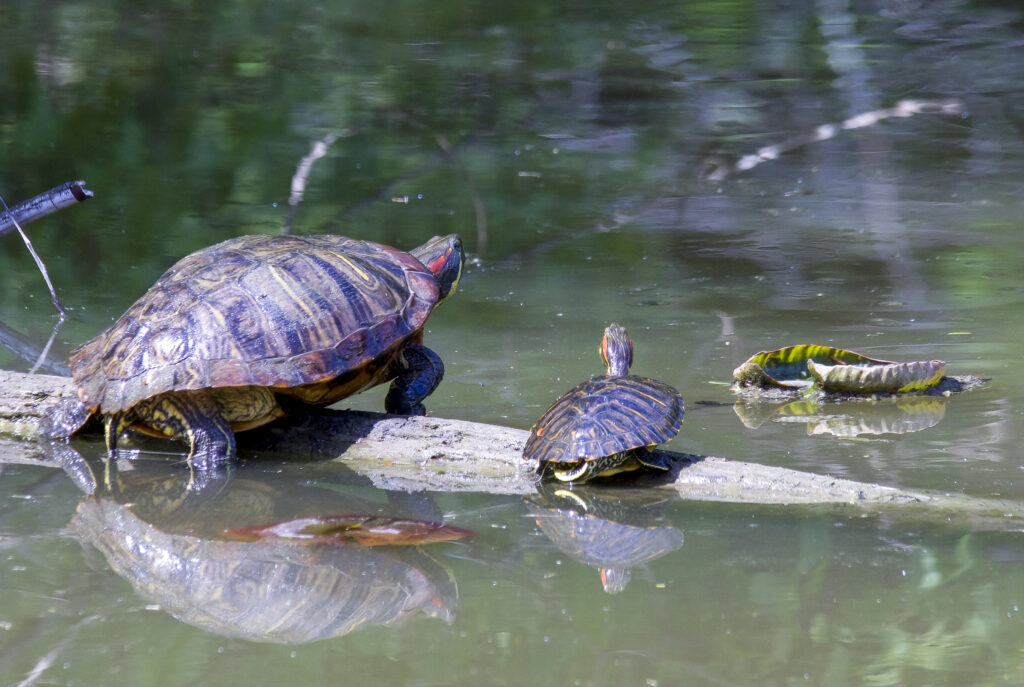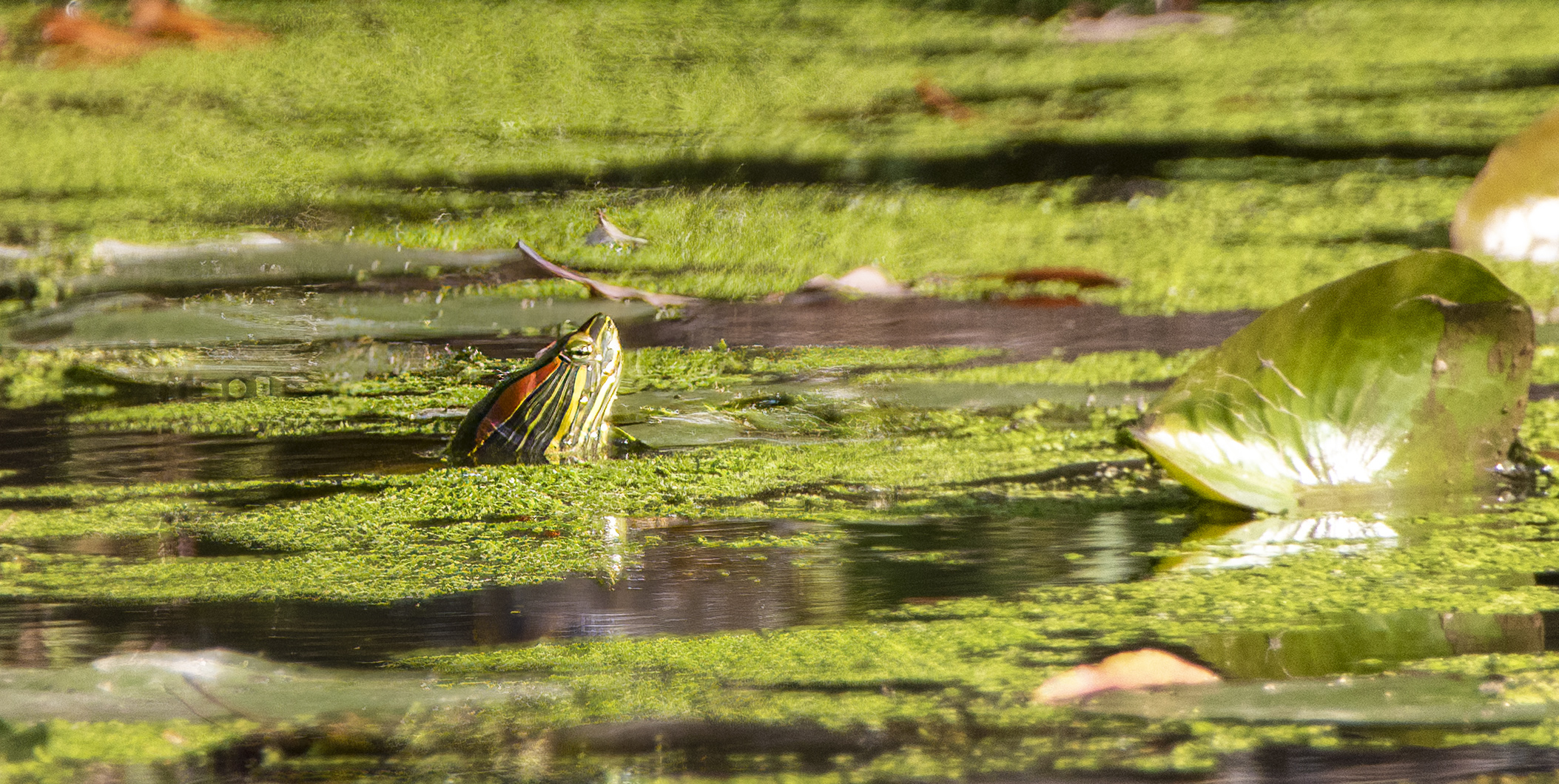“There’s one!” I said to myself. I had just spotted a turtle climbing out of the duckweed carpeting the slow-moving water along the Green Ribbon Trail in St. Catharines. It was the day before Thanksgiving, and the cool morning had given way to warm sun. I had worried it was too late in the season for turtles, but nearly three hours into my search, I had finally spotted my first turtle.
COVER PHOTO: A red-eared slider pokes its head above water along the Green Ribbon Trail in St. Catharines. The red-eared slider is considered invasive as it may outcompete native species such as the Midland Painted Turtle for food, nesting locations or even basking spots.
It wasn’t long before the first turtle was joined by a second. Both were Midland Painted Turtles (Chrysemys picta marginata), one of the most common reptiles native to Niagara. Painted turtles are named well, with their bright yellow striped heads and shells splashed with red. They can be spotted on sunny days basking near quiet bodies of water almost anywhere in the peninsula, from farm ponds and ditches to slow-moving sections of our rivers.
A third turtle clambered up onto a rock. This one was larger than the other two, and as it basked, I spotted a red flag — or, rather, a red ear. The newcomer was an invasive red-eared slider (Trachemys scripta elegans).
The red-eared slider is native to the southern United States and Mexico. However, due to its popularity in the worldwide pet trade, escaped or deliberately released pets have established breeding populations in far-flung places like Bermuda, Europe, and even Australia. In 2000, the World Conservation Union declared the red-eared slider one of the world’s worst invasive species, and the import or possession of this turtle is tightly controlled in many places.

At first glance, the red-eared slider may be mistaken for a painted turtle, but they can be easily told apart by their namesake red “ear” marking behind their eye, and their lower shells which are yellow with black markings.
Red-eared sliders and painted turtles both primarily feed on aquatic invertebrates and plants, and they both seek nesting locations in soft earth, near their home bodies of water. On average, red-eared sliders grow to a larger size than our native painted turtles and may therefore gain an advantage when competing with our native turtles for food, nesting sites, or even basking locations.
By the time I called it a day, I had spotted eight turtles basking at the same time along the Green Ribbon Trail. Five, including the largest, were red-eared sliders. The two smallest were also red-eared sliders, and that may indicate that they are successfully reproducing here in Niagara.

While they may not have the same visibility as other infamous invasive species like the round goby or purple loosestrife, nature lovers and turtle owners should take care to limit the spread of this species. If you own a red-eared slider and cannot care for it any longer, contact the breeder or store that supplied the pet. Never release a pet back into the wild. Former pets may struggle to find shelter or food, or they may expose wild populations to diseases. If a breeder or store cannot take the animal, contact your local humane society or reach out to potential owners through social media.
The Green Ribbon Trail is dedicated to missing children across the world. It is a beautiful location to pause, reflect, and enjoy nature. The wetlands bordering the trail are prime habitats for our native birds, reptiles and amphibians. And while it may seem an idyllic and serene location to release a pet turtle, it would be unfair to both the former pet and the native turtles already living there. Rehome, never release.
Regarding the snakes of September
Thank you to readers of last month’s article on the snakes of Niagara – a few wrote to ask which of our snakes are venomous. The only snake with medically important venom in Niagara is the massasauga rattlesnake. Due to its limited range, it rarely comes into contact with humans. The only verified observations on iNaturalist for the massasauga are near the Wainfleet Bog; it is also reported along the shores of the lower Niagara River, but there are no recently confirmed observations on iNaturalist for that location.
The ring-necked snake, while considered harmless, is also venomous. Due to its shy nature, small size, and rear-fanged venom delivery, it is unlikely to injure anyone unless allowed to chew on a finger. Recent research also indicates that the common gartersnake has venom in its saliva, which it may produce itself or acquire by feeding on toxic amphibians. This venom is not considered dangerous to humans.
Regardless of potential venom toxicity, bites from any animal should be cleaned and disinfected to reduce the risk of secondary infection from bacteria. Venom may also cause an allergic reaction, so it is best to treat all animal bites properly.
